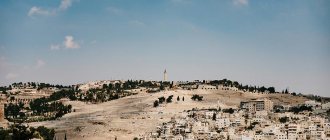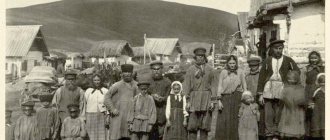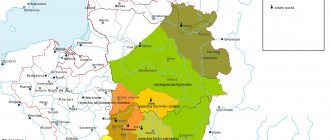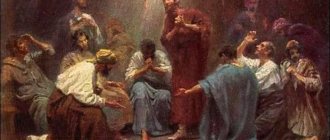Stages of exile [↑]
In 3318 (443 BC) Nebuchadnezzar reigned in Babylon and conquered first Ninveh and then Judea. The Jewish king Jehoiakim submitted to him and promised to pay tribute without waiting for the siege of Jerusalem. The prophet Irmiyahu, who lived at that time, prophesied about the conquest of Jerusalem by Babylonia and called on the king and people of Judah not to resist Nebuchadnezzar.
The Jews did not listen to the prophet and rebelled against Babylonian rule. Nebuchadnezzar's forces attacked Jerusalem and captured "three thousand twenty-three Jews" ( Yirmiyahu 52:28
): all the nobility, among whom was King Yehoiakim with his family and retinue, as well as the prophet Yehezkel, who became one of the spiritual leaders of the exiles.
A few years later, ten thousand more Jews were sent into Babylonian captivity: all the dignitaries, seven thousand troops, a thousand “artisans and blacksmiths,” and in Judea “there was no one left except the poor people of the land.” The utensils from the Jerusalem Temple were also taken to Babylon.
Another 11 years later, in 3338
(422 BC), after a long siege of Jerusalem and the destruction of the Temple, almost all the surviving Jews were driven to Babylon.
But, having completely defeated the kingdom of Judah, Nebuchadnezzar did not want to turn it into a desert. Therefore, he allowed the commoners to remain on their lands to cultivate and cultivate them. Gedaliah ben Ahikam as their governor.
, a wise and God-fearing person.
Historical background
The Bible, Babylonian chronicles and Herodotus's History show that expulsions of the population were a common policy of the Babylonian and then Persian kings, but in terms of mass, these expulsions were inferior to the Assyrian ones.
Assyrian policy was to resettle the population of newly annexed national kingdoms or the population of vassal kingdoms that had rebelled against Assyria, so that within the empire there were no consolidated national-political units that could seek to restore their independence. As a result of this policy, by the middle of the 7th century. BC e. in the territory of the Fertile Crescent there were almost no national kingdoms left that could pose a potential threat to the unity of the empire.
Regarding the Babylonian and Persian periods, there is no information about the relocation of settlers to the place of the expelled population, which was typical for the Assyrian period.
The number of exiles given in the Bible is inconclusive. Although we can agree that the number of those expelled with Jehoiachin is rounded - ten or seven thousand people, while Jeremiah gives the exact figure (3023 people), it is difficult to admit that the number of those displaced during the 3rd exile, which accompanied the fall of the kingdom of Judah, was only only 832 people.
In general, it is impossible to accept the total figure given by Jeremiah (52:30) for all five exiles - 4600 souls - simply because the number of those who returned from exile (many exiles chose to remain in Babylonia) was 42,360 people, not counting 7337 male and female slaves and 245 singers (Neh. 8:66–67). Apparently, during the five exiles mentioned in the Bible, several tens of thousands of people were driven away from Judea.[2]
In terms of the demographic impact of the exile, it must be taken into account that the original population of Judea was hundreds of thousands of people (possibly up to a million). After the expulsion, the country became desolate because:
- many people outside Jerusalem died during the Babylonian invasions and because of the devastation they caused (died of starvation);
- people fled en masse from the advancing enemy troops and emigrated from plundered areas;
- after the capture of all military forces, the country remained defenseless against any aggressors other than Babylon, who also robbed, killed and drove people into slavery and provoked flight abroad.
Life in Babylon [↑]
The Babylonian Empire extended from the Persian Gulf to the Mediterranean Sea, and all its constituent states greatly enriched it. The Babylonian sages knew how to influence supernatural forces; the Babylonian army won numerous wars. And now, in the center of this huge country, there was a small people who came here from the shores of the Mediterranean Sea.
The Jews arrived in Babylonia exhausted, defeated, shocked by the horrors of siege and captivity. Here, however, they discovered a Jewish community founded by sages and scholars brought there by Nebuchadnezzar eleven years earlier.
The authorities granted Jews autonomy in resolving internal issues. A gigantic empire ruled numerous nations, and the main thing for the rulers of Babylon was to receive taxes from their subjects.
The Jews in Babylon were in serious danger: they lived among the Gentiles and could adopt their customs, however, this exile was the beginning of the revival of our people.
In Babylonia, the exiles began a new life. Their social status was quite satisfactory, they enjoyed all the rights of citizens. They were settled in central and southern Mesopotamia. Most of the Jews were found in the agricultural region of Nippur in the center of Babylonia.
The area suffered greatly during the wars between Babylon and Assyria, and the Babylonian kings apparently made efforts to restore it economically. The settlement of Tel Aviv, where Yehezkel prophesied, was also located there. Other settlements were called Tel Melach, Tel Harsha, Kruv, Adan, Imer.
In some ways, the Jews were forced to adapt to local conditions, but they preserved the main thing: Tradition. Hebrew continued to be used along with Aramaic, Jewish holidays were observed on their traditional dates, and children were given Jewish names even in the fifth and sixth generations living in Babylon. Circumcision, observance of the Sabbath and fasts, and consecration of the New Moon were performed.
In the absence of the Temple, the Jews found themselves in a shockingly new situation: the inability to make sacrifices. And here, in Babylon, other forms of service are forced to become the main ones: prayers, repentance and fasting. Making prayer a central element of ministry was seen by the exiles as a temporary condition. One of the first actions of those returning from the Babylonian captivity (even before the founding of the new Temple) was to build an altar and resume sacrifices ( Ezra 3:1-6
).
Leaders of the Generation of Exile [↑]
Throughout the years of exile, the continuity of the Davidic family continued to be preserved. King Jehoiakim, expelled from Jerusalem to Babylon and kept there in captivity, 3364
year /396 BC/ was released and became the head of the Jewish exiles.
After the death of Yehoyakim, his son Shaltiel succeeded him. Shaltiel's grandson was Zerubabel, who replaced his grandfather at the head of the Jewish community of Babylon ( Seder olam zuta
7:10;
Seder Hadorot
3364).
Elders, priests and prophets played a vital role in the life of the Jews in Babylon. We read from the prophet Irmiyahu that he is turning from Jerusalem ( 29:1
): "...to the elders (who) were in exile, and the priests, and the prophets, and all the people, whom Nebuchadnezzar drove out of Yerushalayim to Bavel."
The disciple of the prophet Irmiyahu, Baruch ben Nerya, became the successor of his teacher and the spiritual leader of the generation, instilling in his many followers a love of the Torah. Among his disciples in Babylon was the scribe Ezra, who became the head of the next generation of sages.
Soon after his death, Ezra ascended to the Land of Israel, where he created a strong community that rallied around the Temple rebuilt in Jerusalem. Thus, Baruch became a spiritual “bridge” connecting the generation of sages of the First Temple with the sages of the Second Temple.
Jews settled in Babylon by clan and class groups (which usually coincided, since occupations were inherited) led by elders, whose role, which had diminished during the period of the First Temple, increased again in exile.
The elders of Israel came to the prophet Ezekiel (20:3
): “Son of man! Speak to the elders of Israel and tell them...” They are repeatedly mentioned in the books of Ezra and Nehemiah as organizers of preparations for the return from Babylon, participants in raising funds for the restoration of the Temple of Jerusalem, and mediators in negotiations with the Persian authorities during construction.
The priests (kohanim) continued their main occupation before the exile - studying and teaching the Torah. We see that in Ezra 7:11, Nehemiah 8:9
and others, the status of Ezra is emphasized - “priest, scribe”, and about the Levites it is said: “And they read the book of G-d’s Torah clearly and with an interpretation of what they read” (Nehemiah 8:8). Ezra was a direct descendant of the priest Pinchas, the grandson of the high priest Aaron.
Other groups of temple servants also continued to survive in exile: among those who returned were families of singers, gatekeepers, and netinim (temple servants).
[edit] Return from captivity
The appearance of the Persian army under the leadership of King Cyrus at the borders of Babylon in 539 BC. e. gave the exiled Jews hope for deliverance. This hope was justified when Cyrus, having captured Babylon almost without fighting, issued at the beginning of 538 BC. e. a decree allowing exiles to return to Judea and rebuild the Temple of Jerusalem. Excerpts from Cyrus' decree appear in the Book of Ezra in two textual versions—Hebrew[27] and Aramaic[28]; the latest version establishes the dimensions of the Jerusalem Temple being restored and contains an order to pay construction costs and to return the temple utensils seized by Nebuchadnezzar II. The decree of Cyrus, whom the exiles perceived as a deliverer sent by God, caused a general upsurge, clearly expressed in the prophecies of Second Isaiah, culminating in the return of the exiles to their homeland - Shivat Zion (“return to Zion”).
The Jews were the only people exiled by the Assyrians and Babylonians to return to their homeland. The first group of several thousand people, led by Sheshbazzar, left Babylon already in 538 BC. e.; others followed. Those who remained were mainly those who did not have land ownership in Judea or who took root in Babylon. They marked the beginning of the Babylonian diaspora.
All Jews, to whom the memory of Jerusalem was dear and sacred, responded to the call of Cyrus’ decree to return. But there were few of them, only 42,360 people with 7,367 servants and maids. These, with a few exceptions, were all poor people, having only 736 horses, 245 mules, 436 camels and 6,720 donkeys. A much larger mass of the captive people - all those who managed to acquire a household and achieve significant security in the country of captivity - chose to remain there, under the magnanimous rule of Cyrus. The majority between them belonged to the upper and rich classes, who easily lost their faith and nationality and were reborn as Babylonians. The caravan of immigrants, taking with them 5,400 vessels of the temple, once captured by Nebuchadnezzar and now returned by Cyrus, set off under the command of the noble Jewish prince Zerubbabel and the high priest Jesus, who led them to the old native ashes, where from these immigrants the Jewish people were reborn.
For those who chose to remain in Babylon, prayer was the main form of worship. The preservation of national-religious identity in exile was facilitated by the ritual of circumcision, the observance of Shabbat and three fasts timed to coincide with the three stages of the siege of Jerusalem: 9 Tammuz, 7 or 10 Av, 10 Tevet, as well as the fast of Gdalia in the month of Tishrei.
The Babylonian captivity created a deep national feeling and an isolationist concept, which was expressed in a sharp differentiation between the returning exiles and the Jewish population remaining in Eretz Israel, which largely mixed with the Samaritans. Upon his return, Ezra led an irreconcilable struggle against mixed marriages, which contradicted the concept expressed by Deuteronomy and Zechariah.
Jewish prophets in Babylon [↑]
The role of the prophets was especially great in the spiritual sphere, namely, in opposing idolatry and polytheism of the surrounding peoples. The fact that the exiles remained faithful to Jewish traditions testifies to the success of the prophets. From this period all idolatry completely disappeared.
All the predictions of the prophets who warned the Jews against future misfortunes came true. Therefore, now the exiles listened with special hope to their words about the impending liberation.
Daniel [↑]
Among the captives of the first wave were the righteous man and seer Daniel, who came from the tribe of Judah and belonged to a noble family, as well as his friends Hananiah, Mishael and Azariah. For three years, the captive youths were taught the Babylonian language and various sciences, after which they were taken into the retinue of Nebuchadnezzar.
Two years after the destruction of the Temple of Jerusalem, Nebuchadnezzar saw a dream that greatly alarmed him, but upon awakening he forgot the content of the dream, and no one could restore or unravel it. Only Daniel the Creator revealed the answer to the prophetic dream. Daniel reminded the king that he had seen in a dream “a huge idol, ... the head of which was of pure gold, the chest and arms of silver, the belly and thighs of copper, the legs of iron, and the feet partly of iron and partly of clay " ( Daniel
2:1-33, Rashi;
Seder Hadorot
). According to Daniel, the four parts of this idol symbolized the four kingdoms that would rule the world throughout history and subjugate the children of Israel, and the first of these four kingdoms was Babylon.
Prophet Yirmiyah [↑]
Long before the destruction of the Temple, Irmiyahu warned the Jews against dissolving among foreign peoples and worshiping foreign gods. But the Jews of Judea were so accustomed to sin that change for the better became almost impossible for them. In such a situation of general spiritual decay, retribution becomes inevitable. And the scourge of retribution was to be hordes of conquerors: “I will bring against you, house of Israel, a people from afar,” said G‑d, “this is a mighty people, an ancient people, whose language you do not know and you will not understand what they say” ( Irmiyah 5:15
).
“I will throw you,” says the Creator through the mouth of the prophet, “from this country to a country that neither you nor your fathers knew” ( Irmiyah 16:13
). As you know, the Jews did not listen to their prophet, and everything happened according to the word of G-d. At the end of his life, Yirmiyah continued to proclaim his prophecies in Babylon.
There were false prophets in the Babylonian exile, whose predictions encouraged the Jews to make mistakes and believe that their stay in Babylon was short-lived and they would return to their homeland very soon, so there was no point in “settling” in a new place. But the prophet Yirmiyah called on the Jews of Babylonia: “Build houses and live in them, plant gardens and eat their fruits” ( Yirmiyahu 29:6
).
He also indicated the period of the current exile: “The Lord said: When Babylon is seventy years old, I will remember you and fulfill My good word for you about returning you to this place” ( Yirmiyahu 29:10-11
).
Prophet Yehezkel [↑]
The Prophet Yehezkel ben Buzi Hakohen reproached the people for their sins and at the same time supported and consoled the Jews, saying that they should not despair, because the Holy Land was given as an inheritance only to the people of Israel, and not to those who expelled them from their homes and took them away so far from home. The exiles will return home to their native land and repent of their sins:
“And I will call you from among the nations, and I will gather you from the countries where you were scattered, and I will give you the land of Israel” ( Ezekiel 11:16
). Yehezkel predicted the capture of Jerusalem by Nebuchadnezzar, and also prophesied that the day would come when the exiles would return to Jerusalem, who would not only restore the city, but also build a new Temple.
When the time came for the Babylonian captivity, the prophet did not abandon his mission. He continued to instill hope for liberation in the hearts of the exiles. In his famous prophecy of the withered bones being “put on with flesh” and “given with spirit,” he predicted that Zion would rise from the ashes and his sons would return there, not only the living, but also the dead.
Like the prophets who preceded him, Yehezkel predicted not only deliverance from Babylonian captivity, but also complete Liberation.
Prophet Havakuk [↑]
The prophet Havakuk also predicted the rise and subsequent fall of the Babylonian kingdom. According to him, the Most High will exalt Babylon in order to use it to punish the children of Israel: “You created it for punishment” ( Hawakuk 1:12
).
Literature
- Graetz G. History of the Jews from ancient times to the present. 2nd revised edition. T. 1–12 / Translation from the German edition edited by O. Inber. Odessa, 1906-[1909].
- Cyrus Herzl Gordon. Forgotten letters. St. Petersburg, “Eurasia” 2002 (Original: Cyrus H. Gordon. Forgotten scripts. New York: Basic Boocs, Inc., 1982)
- Diamont M. Jews, God and History / Translation from English by R. Nudelman. Ier., 1979. 530 p.
- Dubnov S. M. World history of the Jewish people from ancient times to the present. T. 1–10. Riga, 1936–1939.
- Jewish history and religion: Collection of articles / Kaufman I., Finkelstein L., Ettinger S. Translation from Hebrew and English by A. Ginzai and E. Lomovskaya. Ier., 1982. 264 p.
- Mysteries of Jewish history: Sat. / Compiled by R. Nudelman. M. - Ier., 1990. 208 p.
- Werner Keller. “The Bible as History”, Moscow, Kron-press, 1998. Translation from Werner Keller “The Bible as history” 1980 by Hodder and Stoughton.
- Roth S. History of the Jews from ancient times to the Six-Day War. Translation from English Tel Baruch, [b.g.]. 428 pp.
- Samuels R. Along the Paths of Jewish History: Translation from English. Ier., 1987. 368 p.
End of the Babylonian Empire [↑]
After the death of Nebuchadnezzar, the power of Babylonia began to decline. His son Mardoc (Merodoch) was killed in the twenty-third year of his reign. A time of troubles followed, when kings quickly replaced each other. Then King Navonidas ascended the throne. He was a weak-willed man who transferred control of the country to his son Belshazzar (Belshazzar). During the days of his reign, the victorious army of the Persian king Koresh (Cyrus) appeared at the borders of Babylonia.
Belshatzar opposed a powerful enemy, but was defeated. However, Koresh could not capture Babylon for a long time, because on one side it was protected by a thick fortress wall, built earlier against the Medes, and on the other side of the city there were large lakes and the Euphrates River flowing. Within these borders, Babylon felt calm and safe, and so five years passed until Koresh ordered the waters of the Euphrates to be diverted to another channel and thus open access to the city.
Belshatzar was confident that the powerful fortress wall and river would reliably protect the capital, and did not expect danger. One night he threw a feast for his entourage and, boasting to them, ordered the precious vessels captured by Nebuchadnezzar in the Jerusalem Temple to be taken out of the storerooms. While the guests were celebrating, singing, eating and having fun, glorifying their gods, strange writing suddenly appeared on the wall of the palace. The Babylonian sages tried to read the inscription, but could not. Then they called the sage Daniel, and he read: “Mene, mene, tekel ufarsin.”
.
Daniel interpreted these words as follows: “for me,
God has numbered your kingdom and put an end to it;
tekel
- you are weighed on the scales and found very light;
paras
- your kingdom is divided and given to the Persians.”
That same night, after a feast during which the sacred vessels of the Temple were desecrated, Belshatzar was killed. Power in the country passed into the hands of the Persians and Medes. The empire was ruled by the Median king Darius for a year, and after his death the Persian king Koresh ascended the throne. By this time (3391) seventy years had passed since the Babylonian captivity of the Jews and the powerful Babylonian Empire had come to an end, according to the word of the prophets.
Notes
- Tyumenev, 1922, p. 59-70.
- Shterenshis, 2008, p. 116-117.
- Babylonian captivity // Encyclopedic Dictionary of Brockhaus and Efron: in 86 volumes (82 volumes and 4 additional). - St. Petersburg, 1890-1907.
- ↑ 123
Shterenshis, 2008, p. 111. - Shterenshis, 2008, p. 113.
- Julius Oppert (1825-1905) - the largest French Assyrologist; Lopukhin A.P., “Explanatory Bible.” Stockholm, 1987, book 1, volume 3, p. 416; Dandamaev M. A., Lukonin V. G. “Culture and economy of ancient Iran.” M.: Nauka, 1980, p. 22; [www.jewishencyclopedia.com/view.jsp?artid=967&letter=A Jewish Encyclopedia]
- Greek translation of the Book of Esther in the Septuagint; Josephus, Antiquities of the Jews XI, 6:1
- Abul-Faraj bin Harun (Bar-Ebrey); Jacob Hoschander is a modern researcher.
- Alexander Topaller, “Riddles of Biblical History.” Publishing house "Isradon", 2006








